The AMD 2nd Gen Ryzen Deep Dive: The 2700X, 2700, 2600X, and 2600 Tested
by Ian Cutress on April 19, 2018 9:00 AM ESTPrecision Boost 2 and XFR2: Ensuring It Hertz More
One of the biggest changes for the new Ryzen-2000 series is in how the processor implements its turbo. Up until this point (except the recent APU launch), processors have relied on a step function implementation: the system determines how many threads are loaded, attempts to implement a specific frequency on those cores if possible, and then follows the look-up table relating thread count to frequency. AMD’s goal in Precision Boost 2 is to make this process more dynamic.
This image from AMD is how the feature is being represented: the system will determine how much of the power budget is still available, and turbo as much as possible until it hits one of the limiting factors. These factors can be any of, but not limited to, the following:
- Total chip peak power
- Individual core voltage/frequency response
- Thermal interactions between neighboring cores
- Power delivery limitations to individual cores/groups of cores
- Overall thermal performance
AMD’s new Ryzen Master 1.3 software, when used on a Ryzen 2000-series processor, has several indicators to determine what the limiting factors are. For the most part, the way the processor will boost and respond to the environment, will be transparent to the user.
The best way to test this in action, from my perspective, is to look at the power draw of the first generation and second generation Ryzen processors. We can examine the internal estimated power consumption of each core individually as thankfully AMD has left these registers exposed, to give the following data:
This is only the core consumption power, not the package power, which would include the DRAM controller, the Infinity Fabric, and the processor IO. This means we get numbers different to the rated TDP, but the danger here is that because the Ryzen 7 2700X has a 10W TDP higher than the Ryzen 7 1800X, where the 2700X draws more power it could seem as if that is the TDP response.
Just plotting the power consumption gives this graph:
Even in this case it is clear that the Ryzen 7 2700X is drawing more power, up to 20W more, for a variable threaded load. If we change the graph to be a function of peak power:
The results are not quite as clear: it would seem that the 1800X draws, as a percentage of peak power, more at low thread count, but the 2700X draws more at a middling thread count.
It is worth noting that the end result of Precision Boost 2 is two-fold: more performance, but also more power consumption. Users looking to place one of the lower powered processors into a small form factor system might look at disabling this feature and returning to a standard step-function response in order to keep the thermal capabilities in check.
A side note – despite the marketing name being called ‘Precision Boost 2’, the internal BIOS name is called ‘Core Performance Boost’. It sounds similar to Multi-Core Enhancement, which is a feature on some Intel motherboards designed to go above and beyond the turbo mechanism. However, this is just AMD’s standard PB2: disabling it will disable PB2. Initially we turned it off, thinking it was a motherboard manufacturer tool, only to throw away some testing because there is this odd disconnect between AMD’s engineers and AMD’s marketing.
Extended Frequency Range 2 (XFR2)
For the Ryzen 2000-series, AMD has changed what XFR does. In the previous generation it was applied on certain processors to allow them to boost above the maximum turbo frequency when the thermal situation was conducive to higher frequencies and higher voltage in low thread-count states. For this generation, it still relates to thermals, however the definition is applied to any core loading: if the CPU is under 60ºC, the processor can boost no matter what the loading is above its Precision Boost 2 frequency (so why not get a better PB2 implementation?). The core still has to be within a suitable voltage/frequency window to retain stability, however.
On certain motherboards, like the ASUS Crosshair VII Hero, there are additional options to assist XFR2 beyond AMD’s implementation. ASUS does not go into specific details, however I suspect it implements a more aggressive version, perhaps extending the voltage/frequency curve, raising the power limits, and/or adjusting the thermal limit.


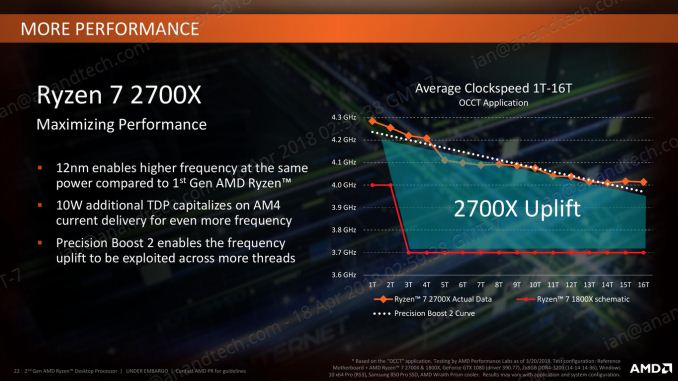
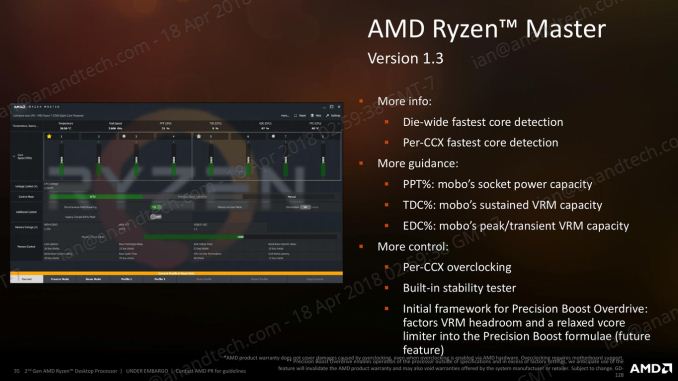

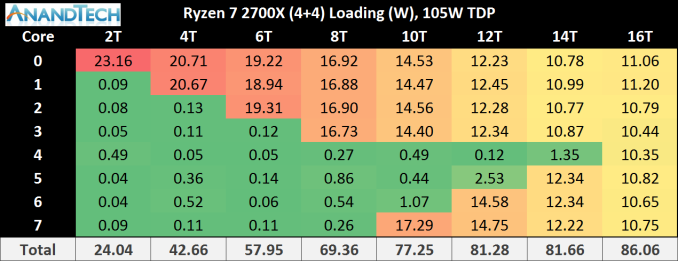
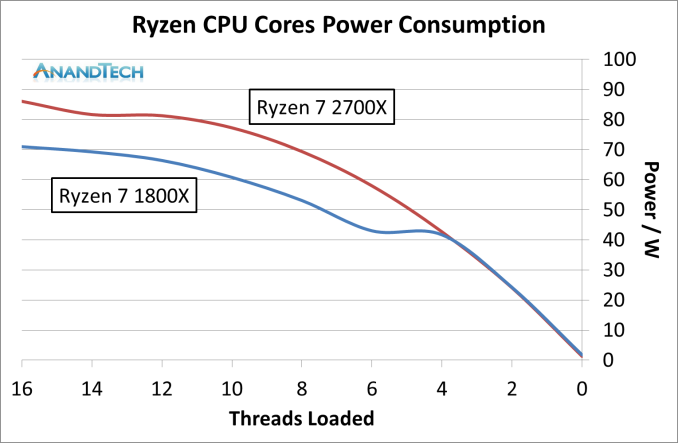
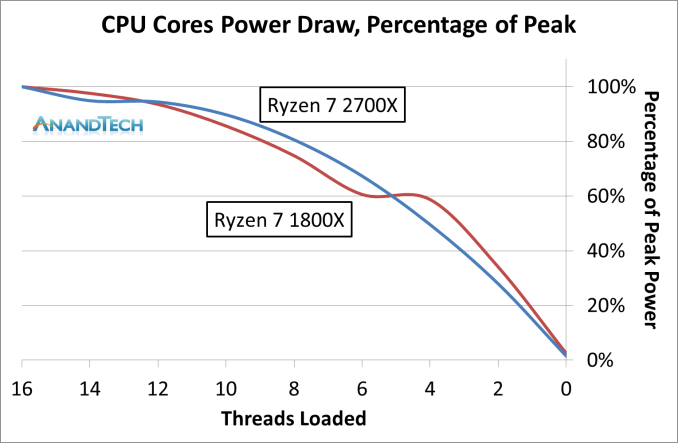
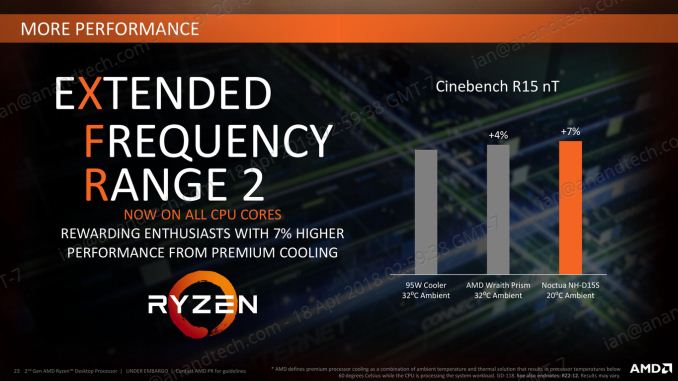








545 Comments
View All Comments
DisoRDeR4 - Thursday, April 19, 2018 - link
Thanks for the review, but I noticed a minor error -- your AMD Ryzen Cache Clocks graph on the 3rd page shows data for the 2700X, but in the preceding text it is referred to as the 2800X.IGTrading - Thursday, April 19, 2018 - link
AMD wins all gaming benchmarks, hands down and does this at a real 105W TDP.In my opinion, it is not fair to say that Intel "wins" the single threaded scenarios as long as we see clearly that the 8700 and the 8700K have the "multi-core enhancement" activated and the motherboard allows them to draw 120W on a regular basis, like your own graphs show.
Allow AMD's Ryzen to draw 120W max and auto-overclock and only the would we have a fair comparison.
In the end, I guess that all those that bought the 7700K and the 8700K "for gaming" are now very pissed off.
The former have a 100% dead/un-upgradeable platform while the latter spent a ton of money on a platform that was more expensive, consumes more power and will surely be rendered un-upgradeable soon by Intel :) while AMD already rendered it obsolete (from the "best of the best" POV) or at least the X370+8700K is now the clear second-best in 99% of the tests @ the same power consumption while losing all price/performance comparisons.
IMHO ... allowing the 8700 & 8700K to draw 120W instead of 65W / 95W and allowing auto-overclocking while the AMD Ryzen is not tested with equivalent settings is maybe the only thing that needs to be improved with regards to the fairness of this review.
Thank you for your work Ian!
Luckz - Monday, April 23, 2018 - link
The 2700X draws so much more than its fake on-paper TDP it's not funny. With XFR2 and PB2 of course.PBO can add even more.
Ninjawithagun - Thursday, April 19, 2018 - link
Incorrect comparison. Why does every review keep making the same mistake?? It has nothing to do with price. Comparing like CPU architectures is the only logical course of action. 6 core/12 thread vs 8 core/16 thread makes no sense. Comparing the Intel 8700K 6 core/12 thread @ $347 to the AMD 2600X 6 core/12 thread @ $229.99 makes the most sense here. Once the proper math is done, AMD destroys Intel in performance vs. cost, especially when you game at any resolution higher than 1080P. The GPU becomes the bottleneck at that point, negating any IPC benefits of the Intel CPUs. I know this how? Simple. I also own a 8700K gaming PC ;-)SmCaudata - Thursday, April 19, 2018 - link
I'd like to see more scatterplots with performance versus cost. Also, total cost (MB+CPU+cooler if needed) would be ideal. Even an overall average of 99th percentile 4k scores in gaming (one chart) would be interesting.... hmmm maybe a project for the afternoon.Luckz - Monday, April 23, 2018 - link
The English-language version of the Tomshardware review has a million plots on the last page (14). 4K is complete irrelevant for plotting though since you're GPU-limited there.Krysto - Thursday, April 19, 2018 - link
Wrong. Performance at a given price level is absolutely a metric chip buyers care about - if not the MOST important metric.People usually think "Okay, I have this $300 budget for a CPU, which is the best CPU I can get for that money?" - It's irrelevant whether one has 4 cores or 8 cores or 16 cores. They will get the best CPU for the money, regardless of cores and threads.
Compared core vs core or thread vs thread is just a synthetic and academic comparison. People don't actually buy based on that kind of thinking. If X chip has 15% better gaming performance than the Y chip for the same amount of money, they'll get the X chip, regardless of cores, threads, caches, and whatnot.
Ninjawithagun - Thursday, April 19, 2018 - link
Incorrect. Cost vs. Cost is only one of many factors to consider, but is not a main one, especially if the competition has a processor of equal quality for much less cost. Comparing an Intel 6 core/12 thread CPU to an AMD 8 cores/16 thread CPU makes absolutely no sense if you are measuring cost vs. performance. Your argument makes no sense, sorry.fallaha56 - Thursday, April 19, 2018 - link
Ok by your rationale we should compare Threadripper to 8700k tooNinjawithagun - Thursday, April 19, 2018 - link
Now you are just being stupid.